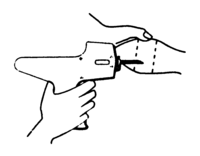
Implanting guidelines
Implants are inserted under the skin of the ear of growing calves. Each implant pellet releases different concentrations of various hormones to help stimulate cattle growth. Proper storage and handling of implants is essential. Always read and follow the label instructions to ensure the selected product is suitable for the animal to be implanted.
Read the guidelines on this page to learn how to safely implant your cattle and talk to your veterinarian to customize your implant strategy.
Implanting in 3 easy steps
1. Restrain the animal.
• The use of a chute and a head gate with neck extenders or calf table is recommended.
2. Clean and locate the implanting site.
• Cleanse the skin at the implant needle puncture site. If necessary, use a stiff brush or scraper to remove mud, dirt and manure. Scrape, disinfect and dry the ear before implanting. Improperly cleansed skin may result in abscess formation and the subsequent loss of the implant.
• The implant is placed subcutaneously between the skin and cartilage on the back, middle third of the ear below the midline. The implant must not be placed closer to the head than the outer edge of the cartilage ring. The location of needle insertion is at a point corresponding to the centre of the ear with the needle directed towards the head, and at least a needle length away from the intended deposition site (see figure). Care should be taken to avoid injuring the major blood vessels or cartilage of the ear.
3. Administer the implant.
• Follow the instructions located on the product label to safely implant your cattle. Click the below buttons for more specific information about implanting with Ralgro® or Revalor®.

Remember…
• Sharp needles make the job easier. They also help prevent ear damage and infection. Replace needles as needed.
• Disinfect the needle between animals by wiping both sides of the needle on a roller or sponge treated with a diluted chlorohexidine solution. Replace the disinfecting solution when it becomes cloudy, or between pens of animals.
• Keep trays, sponges, rollers and implant guns clean.
• Protect implants from dust, dirt or manure during processing.
• Store open implant cartridges in a suitable container to avoid contamination between processing periods. Refer to the product label for storage instructions.
NOTE: Do not use in calves to be processed for veal. Do not use in dairy cattle. Implant pellets in the ear only, any other location may result in violation of law. Do not attempt to salvage implant site for human or animal food. Keep out of reach of children.
